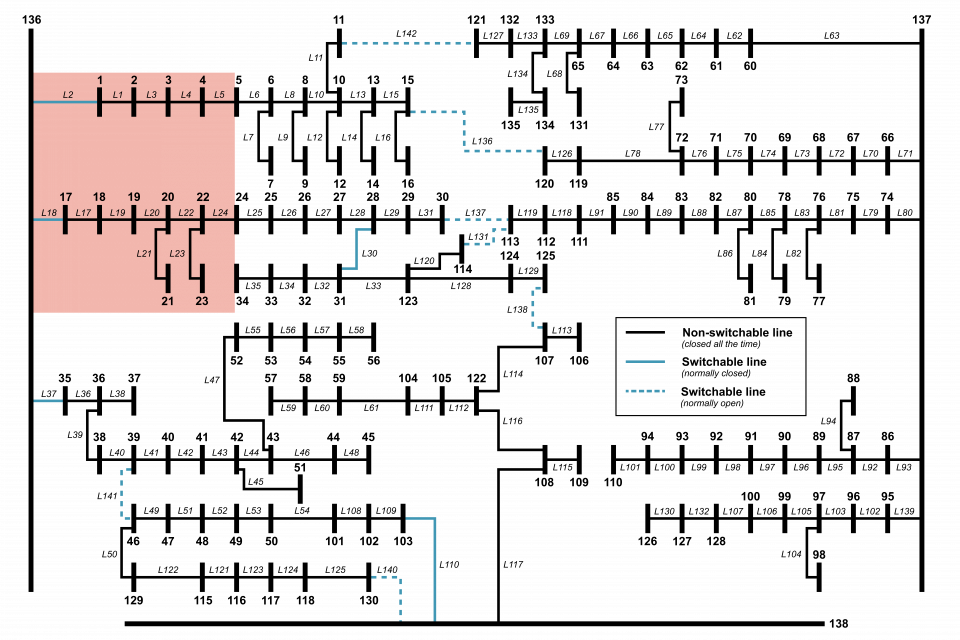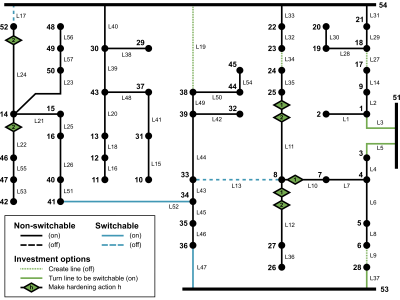Datasets
Standard Dataset
Distribution System Operation Amidst Wildfire-Prone Climate Conditions Under Decision-Dependent Line Availability Uncertainty - Dataset
- Citation Author(s):
- Submitted by:
- Felipe Pianco
- Last updated:
- Tue, 10/08/2024 - 09:35
- DOI:
- 10.21227/318q-5k50
- Data Format:
- License:
 345 Views
345 Views- Categories:
- Keywords:
Abstract
The two distribution systems provided in this dataset are based on the data provided in [1]. The dataset was used in the analysis made in [2], where it was developed a model that can operate the distribution system considering wildfire-prone climate conditions. In this work, we consider that part of the grid is vulnerable to the ignition of a wildfire, which can be influenced by the levels of power flows passing through the line segments within the region. With this model, the operator can make smart decisions on the grid topology by switching available lines to reduce the line failure probability and possible wildfires ignited by those failures.
In the first system, there are 54 buses, 3 substations (buses 51, 53, and 54), and 57 lines. The total demand of the system is 5400 kW, and the energy price is 0.01 $/kWh. In addition, we consider that each switching action costs $100, which can be performed in 11 out of the 57 lines. To enforce radiality constraints, we present in the data a set of rules with lines that cannot be switched on simultaneously. Besides that, part of the grid is located close to vegetation, which renders this area particularly more likely to initiate a wildfire. The southeast area of the grid includes lines L6, L7, L8, L9, L10, L12, L13, L36, L37, L43, L45, L46, L47, and L52. We consider that every line segment has a nominal rate of failure equal to 0.4 failures per year. Using the exponential probability distribution, this rate of failure translates into a failure probability of 0.11% for each line in the next 24 hours (gamma parameter). In addition, due to the adverse climate conditions, each of the aforementioned lines has an increase of 3% in its probability of failure for each 0.01 pu (100kW) of scheduled active power flow (beta parameter). The remaining lines have an increase of 0.0001% in their probabilities of failure per 0.01 pu of scheduled active power flow (beta parameter).
The second data presented refers to a larger and more complex system. In this one, there are 138 buses, 3 substations, and 142 lines, of which 12 are switchable. The total demand of the system is 56,900 kW and the energy price is 0.2 $/kWh. We consider a penalty of 2 $/kWh for loss and surplus of both active and reactive power, and each switching action costs $200. To enforce radiality, we used a DFS (depth-first search) algorithm to identify 12 rules that avoid the simultaneous activation of line segments and result in the formation of cycles within the network. All branches have a nominal rate of failure equal to 0.15 per year and this rate of failure translates into a 0.0411% of failure probability for each line in the next 24 hours (gamma parameter) using the exponential probability distribution. Furthermore, the northwest part of the system is more likely to initiate a wildfire, which includes lines L1-L5 and L17-L24. In this part of the grid, the beta parameter in the dataset provided has the value of 0.667% while the rest of the grid has this parameter as 0.007%.
Together with the dataset a label for every column name is provided as well as a script in Julia language to read the files. The script transforms the data information to pu. For more information about the research that used those data, we ask to see our paper in [2].
[1] G. Muñoz-Delgado, J. Contreras, and J. Arroyo, “Multistage generation and network expansion planning in distribution systems considering uncertainty and reliability,” IEEE Trans. Power Syst., vol. 31, no. 5, pp. 3715–3728, 2016.
[2] Moreira, A., Piancó, F., Fanzeres, B., Street, A., Jiang, R., Zhao, C., & Heleno, M. (2024). Distribution system operation amidst wildfire-prone climate conditions under decision-dependent line availability uncertainty. IEEE Transactions on Power Systems.
Two different cases studies are provided: 54-bus system and 138-bus system. Each case has the main data provided in csv. files inside the folders “54bus” and “138bus”, respectively. In each folder there are: lines information in “IN_Lines.csv”, buses information in “IN_BusesInfo.csv”, forbidden switching patterns in “IN_Forbidden_SW_patterns.csv”, other complementary information in “IN_DataInstance.csv”, and the system diagram in “54Bus_SystemDiagram.pdf” and “138Bus_SystemDiagram.pdf”. The parameters names are explained in the file “ParametersDefinition.txt” together with the units used. A script to read the data in Julia Language is provided in the file “DataReader.jl”, where the function presented transforms the data in pu.








